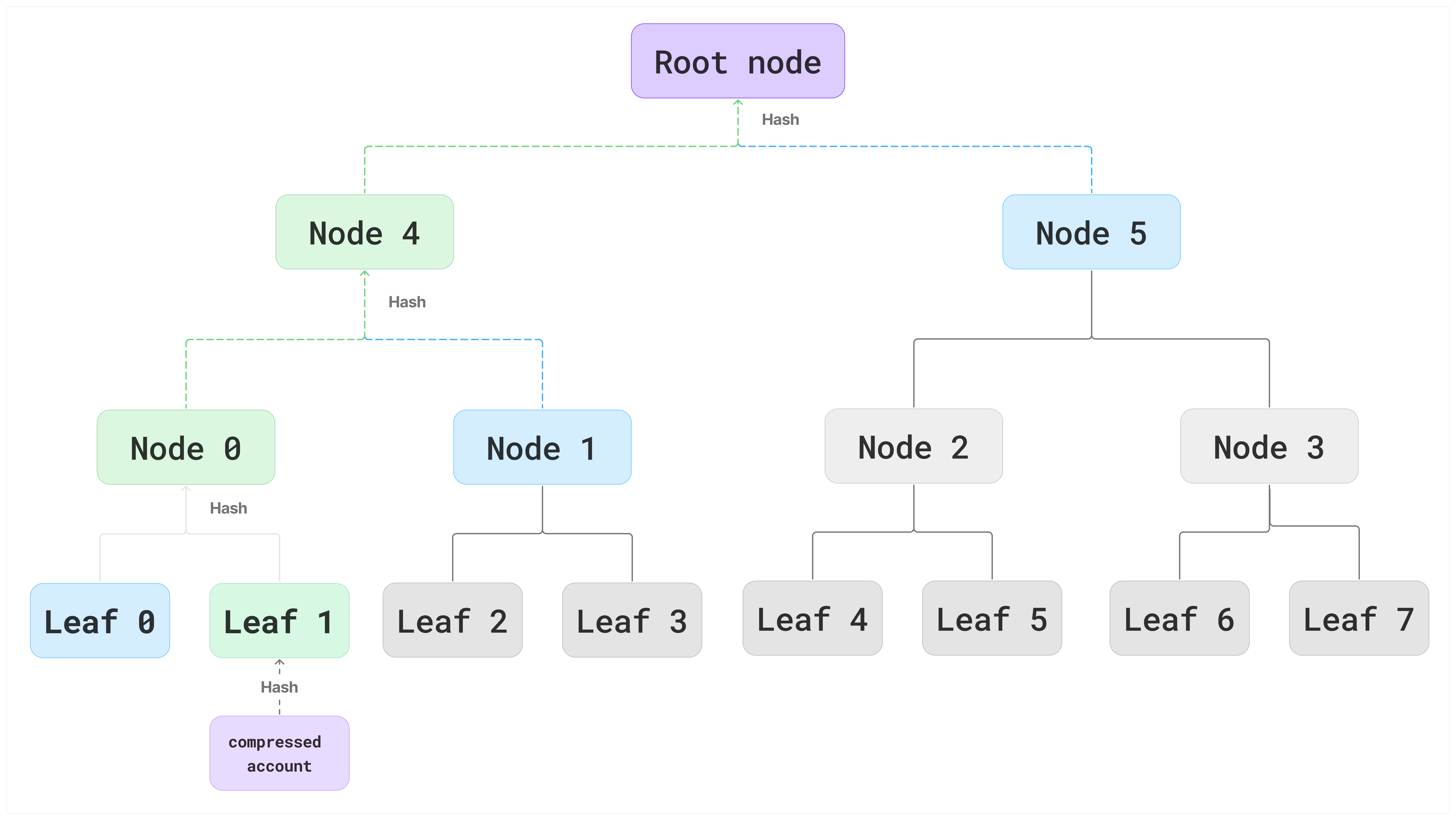Overview
The protocol uses two types of Merkle trees that serve different purposes:- State trees store compressed account hashes
- Address trees store addresses that serve as persistent identifiers
Developers don’t need to maintain or initialize Merkle trees themselves. The protocol maintains Merkle trees at these addresses.
State trees
A state tree is a binary Merkle tree that stores data of millions of compressed Solana accounts in leaves for efficient cryptographic verification the integrity of all leaves in a tree.1
Merkle Tree Structure
A Merkle tree compresses data by hashing adjacent leaves repeatedly into a single root hash, starting from the lowest level. The hash of a compressed Solana account is stored as a leaf in a State tree.2
Merkle Root Hash
Only this root hash is stored on chain as single value on chain to secure the integrity of all compressed state in a tree. The raw state can thus be stored as calldata in the much cheaper Solana ledger space while preserving Solana’s security guarantees.
A Binary state Merkle tree, with depth 3 and proof path for Leaf 1. For ZK Compression, 'Light' state trees have a depth of 26, i.e. contain ~67 million leaves with compressed account hashes per tree.
3
Leaf Hash Structure: Compressed Account Hashes
For compressed Solana accounts, the 32 byte leaf hashes effectively mirror the regular Solana account layout:{DataHash, StateHash; Owner, Lamports.The data_hash represents the fingerprint of the actual account data.The state_hash ensures that each account hash is globally unique. It includes- the public key of the state tree’s respective on-chain account (i.e.,
state_tree_hash) and - the compressed account’s position in the tree (i.e.,
leafIndex).
owner_hashed determines which program owns this account and lamports show the account balance.
Compressed Account Data Structure in Leaf of Merkle Tree.
4
Merkle and Validity Proofs
In state trees, a verifies that a compressed account exists in state trees with a constant 128-byte proof size. This proof must be included in every transaction once a compressed account is created to verify the on-chain state.Developers don’t need to generate validity proofs or learn about ZK to use ZK Compression.ZK Compression uses Groth16, a well-known pairing-based zk-SNARK, for its proof system.
- Merkle proofs consist of sibling node hashes along the path from the account’s leaf to the root.
- Starting with the leaf hash, the verifier calculates up the tree using these sibling hashes. The proof path is shown with three highlighted elements in a box at the bottom right: Leaf 0, Node 1, and Node 5, representing the sibling hashes needed to verify Leaf 1.
- If the calculated root matches the on-chain root, the account is verified.

A Merkle proof path (blue nodes) consists of all sibling node hashes required to calculate the final root node. Only the adjacent hashes along the path to the root are needed.
| Accounts Verified | Proof Components | Size |
|---|---|---|
| 1 | 1 merkle proof | 832 |
| 1 | 1 merkle + 1 ZK proof | 128 bytes |
| 8 | 8 merkle + 1 ZK proof | 128 bytes |
Two state tree versions with different proof mechanisms are currently supported:
- V1 state trees: Always require the full 128-byte ZK proof
- V2 batched state trees: Can use
prove_by_indexoptimization that verifies the account exists with only one byte instead of 128-bytes.
Address trees
Address trees store addresses that serve as optional, persistent identifiers for compressed accounts.Every address is unique within its address tree, but the same seeds can create different addresses in different address trees. To enforce that a compressed account can only be created once with the same seed, check the address tree pubkey in your program.
1
Address Tree Structure
Address trees store derived addresses in an indexed structure. Unlike state trees that store account hashes, address trees store the actual address values along with pointers to maintain sorted order.These addresses are used only when compressed accounts require a persistent identifier that doesn’t change when the account data updates.2
Address Tree Root Hash
Like state trees, only the root hash is stored on-chain to verify all addresses in the tree. The raw addresses are stored in the Solana ledger.3
Merkle and Validity Proofs
In address trees, validity proofs verify when creating a compressed account with an address that the address doesn’t already exist in a specified address tree. This constant 128-byte proof must be included in the transaction only when creating accounts with addresses, not for subsequent compressed account interactions.Two address tree versions are currently supported:
- V1 address trees height 26 (~67 million addresses).
- V2 batched address trees with height 40 (~1 trillion addresses).